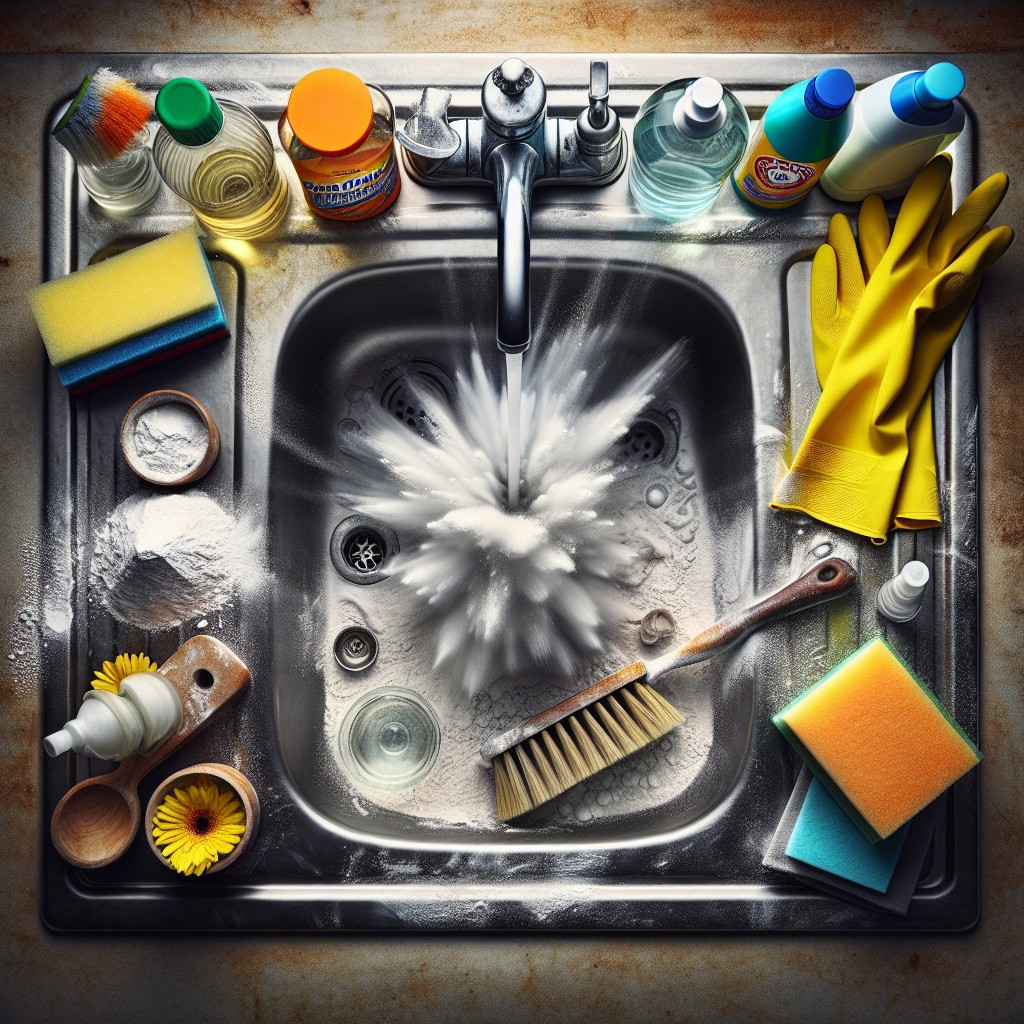Last updated on
In this helpful guide, you’ll learn the best methods and products to effectively clean your kitchen sink, ensuring it shines like new and remains hygienic for daily use.
Key takeaways:
- Consider sink type and material for specific care.
- Gather necessary tools and products for efficient cleaning.
- Soft sponges, toothbrush, and plunger at hand for different tasks.
- Baking soda, vinegar, and dish soap for effective cleaning.
- Use gentle abrasives, natural disinfectants, and thorough drying.
What's Inside
Considerations Before You Get Started

Embarking on a cleaning mission requires a bit of prep work to ensure efficiency and safety. Firstly, gauge the type of sink and its material – stainless steel, ceramic, or porcelain – as each demands specific care.
Next, contemplate the state of your sink; if it’s just daily grime, a light cleanse will do, but if you’re facing stubborn stains or clogs, gear up for a deeper scrub.
Mindful of what’s going down the drain is important, especially if you have a septic system or use eco-friendly cleaning products. Harsh chemicals can damage pipes or disrupt the environmental balance.
Lastly, gather your cleaning tools and products so everything is at arm’s reach, reducing the need for pauses and ensuring a swift process. With these thoughts in mind, you’ll be ready to dive into the task at hand with confidence.
What You’ll Need
Equipping yourself with the right tools and materials is essential for effectively cleaning your kitchen sink. You’ll need an array of items depending on the type of sink and the extent of the cleaning required.
For general cleaning:
- Equipment / Tools:
- Non-abrasive scrubbing sponge or a soft cloth to prevent scratching the sink’s surface.
- An old toothbrush or a small brush for reaching into crevices around the faucet and drain.
- Rubber gloves to protect your hands from any grime or harsh cleaning agents.
- Materials:
- Baking soda, which acts as a gentle yet effective abrasive cleaner and deodorizer.
- White vinegar or lemon juice, both natural acids that help remove hard water stains and disinfect.
- Mild dish soap for everyday cleaning to cut through grease and grime.
- Olive oil or mineral oil for polishing stainless-steel sinks after cleaning.
- Salt, when mixed with baking soda, can help tackle tougher stains with more scrubbing power.
These items are usually readily available in most households and are versatile enough to be used for routine maintenance or a deep-clean session. Remember, the choice of materials might vary if you have special sink materials like copper or a non-stick surface, so always check if the cleaner is suitable for your type of sink.
Equipment / Tools
Equipping yourself with the right tools can transform sink cleaning from a chore into an effortless task. Start with soft sponges or microfiber cloths to avoid scratching surfaces. If dealing with tough grime, a stiff-bristle brush is indispensable for scrubbing without causing damage.
For clogged drains, a plunger and a plumber’s snake will do the trick. Don’t overlook protective gloves to shield your hands from grime and cleaning agents. Finally, a toothbrush proves to be a mighty tool in your arsenal, perfect for reaching those tight spaces around the faucet and handles.
Armed with these tools, you’re set to tackle any level of kitchen sink untidiness.
Materials
To ensure a thorough cleaning of your kitchen sink, gather these essential materials:
- Baking soda provides gentle abrasion for scrubbing without scratching the sink’s surface.
- White vinegar serves as a natural disinfectant, breaking down grease and dissolving mineral deposits while neutralizing odors.
- Dish soap is a staple for cutting through everyday grime and food particles.
- Sponge or soft brush for application without damaging the sink’s finish.
- Microfiber cloth polishes and removes streaks without leaving lint behind.
- Lemon as an optional touch, not just for a refreshing scent but also for its acidic properties that can help disinfect and brighten the sink.
Having these at hand will streamline the cleaning process and lead to spotless results.
Instructions
Begin with the classic combination of baking soda and vinegar for a non-toxic, yet effective way to clean your drain. Pour half a cup of baking soda directly into the drain, followed by an equal amount of white vinegar. The mixture will fizz and bubble—chemistry at work, breaking down grime and food residues. Plug the drain and wait 15 minutes before flushing with boiling water.
For stainless-steel sinks, create a paste using baking soda and water that acts as a gentle, abrasive cleaner. Apply it using a soft sponge, moving in the direction of the stainless steel grain to avoid scratches. Rinse thoroughly with warm water and then wipe it dry with a microfiber cloth to prevent water spots and bring out a lustrous shine.
Remember, though, that stainless steel can be sensitive to certain chemicals; avoid using bleach, which can corrode and discolor your sparkling sink.
Moving on to faucets and handles, these frequently touched surfaces harbor germs and can benefit from disinfection. Use a disinfectant spray or wipes—use sparingly though, as too much moisture around these fixtures can lead to water damage or mold growth. For a deeper clean, unscrew the aerator (if applicable), dislodge debris, and soak it in vinegar.
While every sink may present its unique cleaning challenges, the principles of effective kitchen sink maintenance are universal: gentle abrasives for scrubbing, natural ingredients for safe cleaning, and thorough drying to prevent water spots and buildup.




